Desktop Metal’s DM HH Stainless Steel for Wear, Corrosion Resistance
The company says using DM HH Stainless Steel (DM HH-SS) with its Production System enables customers to go to market at scale and eliminate operations such as plating, which can create supply chain complexity and may be harmful to the environment.

Tight clearance offset socket made of DM HH Stainless Steel. Photo Credit: Desktop Metal
Desktop Metal’s DM HH Stainless Steel (DM HH-SS) is a custom stainless steel alloy that combines high strength and hardness with corrosion resistance, for additive manufacturing (AM) on the company’s Production System platform.
The company says customers can now leverage the Production System’s single-pass jetting (SPJ) technology to produce DM HH-SS components at scale across a range of industries where high strength and hardness are required. With this latest alloy, the Production System can now print 10 qualified metal materials.
DM HH-SS is a custom, heat-treatable alloy that is said to combine the tensile strength, ductility and corrosion resistance of 13-8 PH stainless steel with the added benefit of improved hardness comparable to low-alloy steels, such as 4140. These attributes are said to make the material a key enabling material for companies looking to eliminate the use of low-alloy steels that also require a subsequent plating step for applications needing corrosion protection. DM HH-SS is also well suited for conformally, cooled-injection tool core and cavity applications where millions of injection strokes per year are required, the company says.
According to the company, DM HH-SS is a compelling alternative to 17-4 PH stainless steel because it improves upon its mechanical properties while maintaining corrosion resistance, making it suitable for critical components that previously required the use of low-alloy steels for their high hardness and strength. It is said utilizing the Production System with this alloy enables customers to go to market at scale and eliminate operations such as plating, which can create supply chain complexity and may be harmful to the environment.
Related Content
-
Video: 5" Diameter Navy Artillery Rounds Made Through Robot Directed Energy Deposition (DED) Instead of Forging
Big Metal Additive conceives additive manufacturing production factory making hundreds of Navy projectile housings per day.
-
Big Metal Additive: The Difference Between a Shape and a Part Is Quality
Preparing to scale directed energy deposition to ongoing full production is not a technological challenge: DED is ready. But it is an organizational challenge, says the company founder. Here is what it means to implement a quality system.
-
Seurat: Speed Is How AM Competes Against Machining, Casting, Forging
“We don’t ask for DFAM first,” says CEO. A new Boston-area additive manufacturing factory will deliver high-volume metal part production at unit costs beating conventional processes.











